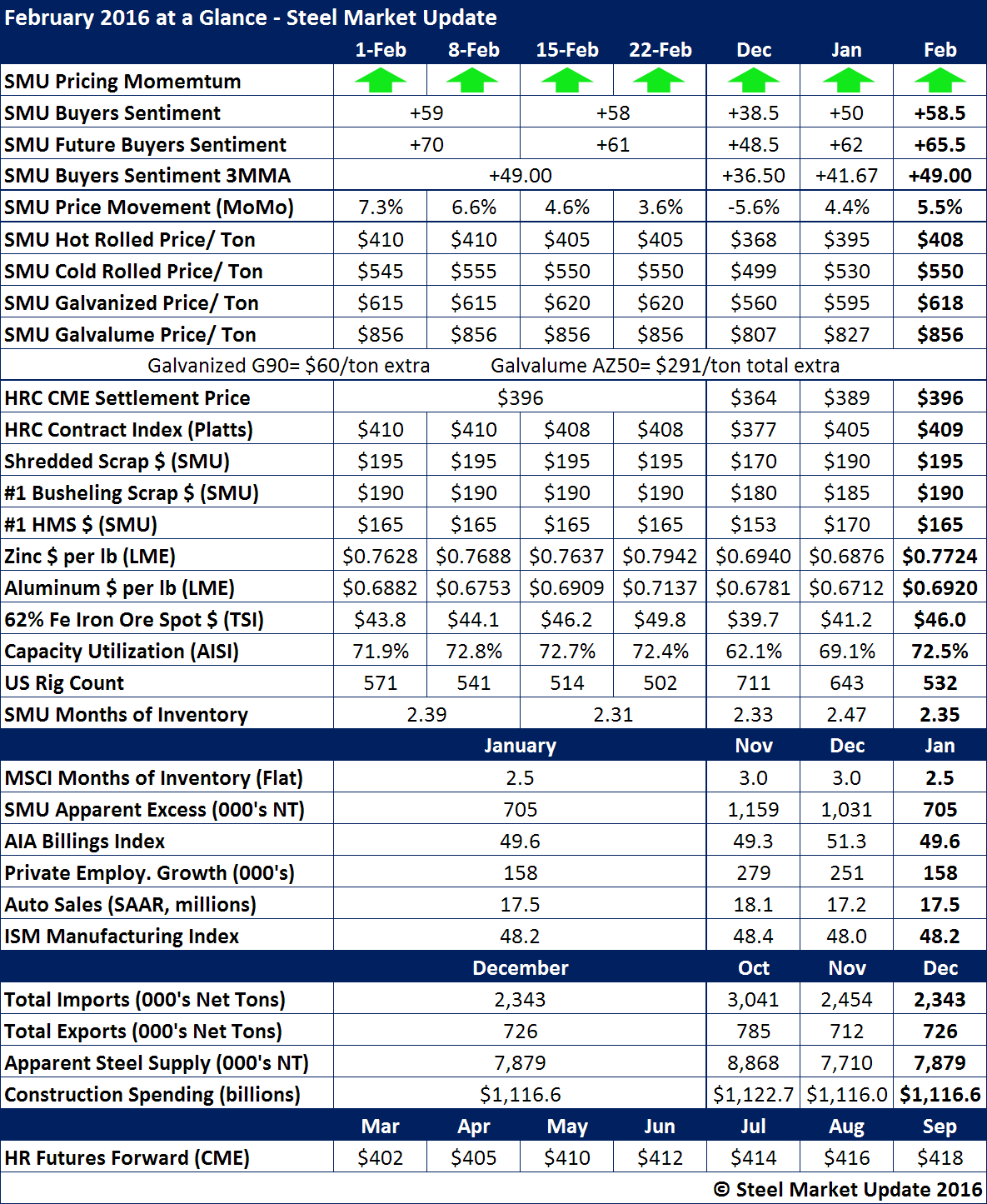SMU Data and Models

End of Month Data for February 2016
Written by John Packard
March 1, 2016
Steel prices continued their three month hike higher as SMU benchmark hot rolled price index (average) for the month was $408 per ton. Even with some minor stumbles noted in hot rolled and cold rolled during the second half of the month, our Price Momentum Indicator is still pointing toward higher prices over the next 30 days. That was reinforced on the last day of the month as SSAB and ArcelorMittal raised plate and sheet spot prices.
Our $408 per ton average was in line with Platts $409 average. The Platts index is one used in some of the domestic steel mill contracts and one that SMU recommends due to its transparency.
The February CME HRC (hot rolled coil) settlement price was $396.
The SMU Sentiment Index improved both on a month to month basis as well as the 3 month-moving-average (3MMA). This, combined with our Service Center Apparent Excess/Deficit dropping by 300,000 tons (and expected to drop further when the February final MSCI numbers come out), are a couple of the reasons why we continue to keep our Price Momentum Indicator pointing toward higher flat rolled steel prices over the next 30 days.
We are seeing a number of the commodity prices rallying as iron ore ended the month just below $50/dmt for 62% Fe fines in China (today ore broke through the $50 barrier) and both aluminum and zinc have rallied off the lows of the month and ended the month on a higher note.
Rig counts, ISM Manufacturing Index, AIA Billings Index and capacity utilization rates are negatives while automotive continues to carry the steel industry on its back.

John Packard
Read more from John PackardLatest in SMU Data and Models

SMU Scrap Survey: Sentiment Indices rise
Both current and future scrap sentiment jumped this month, though survey participants reported responses before key trade news was announced.

SMU Survey: Sentiment splits, buyers have better view of future than the present
SMU’s Steel Buyers’ Sentiment Indices moved in opposite directions this week. After rebounding from a near five-year low in late June, Current Sentiment slipped again. At the same time, Future Sentiment climbed to a four-month high. Both indices continue to show optimism among buyers about their company’s chances for success, but suggest there is less confidence in that optimism than earlier in the year.

SMU scrap market survey results now available
SMU’s ferrous scrap market survey results are now available on our website to all premium members. After logging in at steelmarketupdate.com, visit the pricing and analysis tab and look under the “survey results” section for “ferrous scrap survey” results. Past scrap survey results are also available under that selection. If you need help accessing the survey results […]

SMU flat-rolled market survey results now available
SMU’s latest steel buyers market survey results are now available on our website to all premium members. After logging in at steelmarketupdate.com, visit the pricing and analysis tab and look under the “survey results” section for “latest survey results.” Past survey results are also available under that selection. If you need help accessing the survey results, or if […]

SMU Survey: Sheet lead times stabilize, plate contracts
Mill lead times for sheet products were steady to slightly longer this week compared to our late June market check, while plate lead times contracted, according to steel buyers responding to this week’s market survey.

